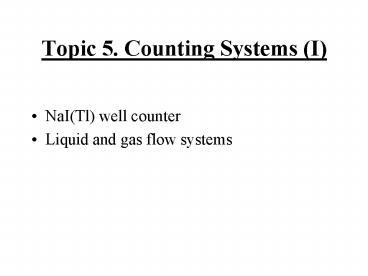Topic 5' Counting Systems I - PowerPoint PPT Presentation
1 / 29
Title:
Topic 5' Counting Systems I
Description:
... product of intrinsic efficiency and photo-fraction ep=efp ... photopeak efficiency may be used to estimate the photo-peak counting rate. Sample Volume Effects ... – PowerPoint PPT presentation
Number of Views:46
Avg rating:3.0/5.0
Title: Topic 5' Counting Systems I
1
Topic 5. Counting Systems (I)
- NaI(Tl) well counter
- Liquid and gas flow systems
2
NaI(Tl) Well Counter
- Detector characteristics
- Detection Efficiency
- Sample volume effects
- Assay of absolute activity
- Shielding and background
- Energy calibration
- Multiple radionuclide source counting
- Deadtime
- Automatic multiple-sample systems
- Applications
3
Detector Characteristics
- Standard well counter (4.5x5cm crystal and
1.6x3.8 well) - Background shielding (gt5cm lead)
- Energy resolution 10-15 FWHM for 137Cs (poor
light transfer between NaI(Tl) crystal and PM
tubes-- light reflection and scattering within
well surface)
4
(No Transcript)
5
Well Counter
6
(No Transcript)
7
Detection Efficiency
- High geometric efficiency (near 100)
- Good for counting of small sample activity
- Intrinsic efficiency e depends on crystal
thickness and ? ray energy (e100 for 1.3-4.5
well thickness and ? ray energy less than 150
keV).
8
(No Transcript)
9
Detection Efficiency (2)
- Photo-peak fraction decreases with increasing ?
ray energy (scattering increases as ? ray energy
increased within 0-2 MeV) - Photo-peak fraction increases with increasing
well detector size (more multiple scattered
photons added into the photopeak)
10
(No Transcript)
11
Detection Efficiency (3)
- Intrinsic photopeak efficiency is the product of
intrinsic efficiency and photo-fraction epefp - Intrinsic photopeak efficiency may be used to
estimate the photo-peak counting rate.
12
(No Transcript)
13
(No Transcript)
14
Sample Volume Effects
- Geometric efficiency of the well counter depends
on the sample positioning - Geometric efficiency will decrease if the sample
is displaced on top of the well. - For a constant activity, increase the volume by
diluting the solution will decrease the counting
rate - For a constant activity concentration, increase
the volume will increase the counting rate and
reach a maximum when the sample exceeds the top
of the well.
15
(No Transcript)
16
Assay of Absolute Activity
- Two methods are used for the determination of
absolute activity from the counting rate
calibration table and calibration (standard)
source - Long-lived radionuclides are used as calibration
(mock) source 137Cs for 131I, 129I for 125I
and 57Co for 99mTc. - Samples absolute activity X is given by X
?A(mock)R(sample)/R(mock), where A is mock
activity and ? the ratio of emission frequencies
17
Shielding and Background
- External sources of background radiation are
minimised by surrounding the detector with lead - The thickness of the lead is typically 2.5-7.5cm.
18
Energy Calibration
- Single channel analyzer attached to well counter
is generally calibrated with 137Cs (1000
divisions for 1Mev) - Adjust the amplifiers gain until maximum
counting rate is observed with the window setting
from 642 to 682 (662 is the centre). - 137Cs calibration is not accurate for energies
below 100 keV because the non-linear energy
response of NaI(Tl) detectors (re-calibration
with low energy source)
19
(No Transcript)
20
Multiple Radionuclide Source Counting
- There is a crosstalk interference if multiple
radionuclide source is counted simultaneously. - Correction is required in order to determine the
true counts for each radionuclides photopeak. - The count ratios of its photo-peak to other
radionuclides photo-peak energies should be
measured by using single radionuclide sample and
for each radionuclide involved. - For a two radionuclides system, the true counts
for each radionuclide are Nt1(N1-R12N2)/(1-R12R21
) and Nt2(N2-R21N1)/(1-R12R21) where R12 and R21
are the count ratios of pure sample at these two
photo-peak energies (R12 from pure sample 2 etc.)
21
(No Transcript)
22
Deadtime
- Deadtime could be easily a problem for well
counter because its high detection efficiency - For a small activity of 1 µCi with a deadtime 4
µsec, about 5,000 cps could be lost if the
detection efficiency is 100 (use
RtRtexp(Rtt)). - Well counter is therefore good for detection of
small radioactivity.
23
Automatic Multiple-Sample Systems
- Automatic multiple sample systems are necessary
for counting large number of samples or repeated
tests - The main problem of the multiple sample well
counters is the background shielding on top of
the wells - SCA, MCA and computers are all being used for the
interface with the detectors.
24
Multiple-Sample System
25
Multi-Sample Through-Hole System
26
Relative Efficiency
27
Applications
- NaI(Tl) well counters are mainly used for in
vitro assay in nuclear medicine (? or x rays)
radioactivity in blood and urine sample,
radiopharmaceutical quality control etc. - NaI(Tl) can also be used for ß emission by
detecting bremsstrahlung radiation.
28
Liquid and Gas Flow Counting
- NaI(Tl) well counters can be used in conjunction
with gas or liquid chromatographs (identification
of different chemical compounds) - Chromatographs are used to separate and identify
different chemical compounds by selective
retention or movement of chemical species in
certain media - Different radioactive species are identified by
comparing radioactivity with the flowing chemical
species (mass signals).
29
(No Transcript)































